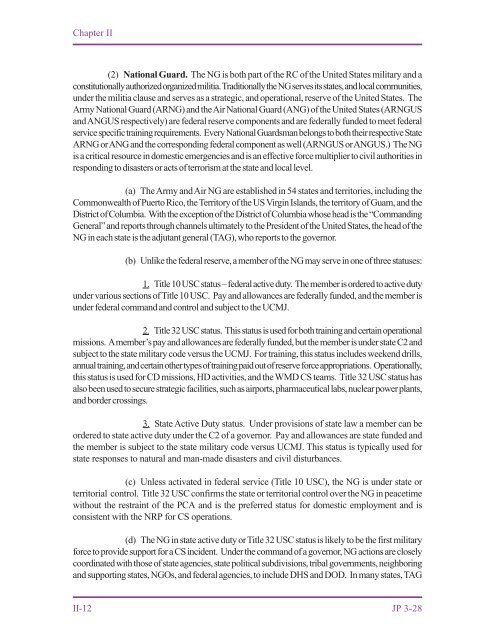JP 3-28, Civil Support - Federation of American Scientists
JP 3-28, Civil Support - Federation of American Scientists
JP 3-28, Civil Support - Federation of American Scientists
You also want an ePaper? Increase the reach of your titles
YUMPU automatically turns print PDFs into web optimized ePapers that Google loves.
Chapter II<br />
(2) National Guard. The NG is both part <strong>of</strong> the RC <strong>of</strong> the United States military and a<br />
constitutionally authorized organized militia. Traditionally the NG serves its states, and local communities,<br />
under the militia clause and serves as a strategic, and operational, reserve <strong>of</strong> the United States. The<br />
Army National Guard (ARNG) and the Air National Guard (ANG) <strong>of</strong> the United States (ARNGUS<br />
and ANGUS respectively) are federal reserve components and are federally funded to meet federal<br />
service specific training requirements. Every National Guardsman belongs to both their respective State<br />
ARNG or ANG and the corresponding federal component as well (ARNGUS or ANGUS.) The NG<br />
is a critical resource in domestic emergencies and is an effective force multiplier to civil authorities in<br />
responding to disasters or acts <strong>of</strong> terrorism at the state and local level.<br />
(a) The Army and Air NG are established in 54 states and territories, including the<br />
Commonwealth <strong>of</strong> Puerto Rico, the Territory <strong>of</strong> the US Virgin Islands, the territory <strong>of</strong> Guam, and the<br />
District <strong>of</strong> Columbia. With the exception <strong>of</strong> the District <strong>of</strong> Columbia whose head is the “Commanding<br />
General” and reports through channels ultimately to the President <strong>of</strong> the United States, the head <strong>of</strong> the<br />
NG in each state is the adjutant general (TAG), who reports to the governor.<br />
II-12<br />
(b) Unlike the federal reserve, a member <strong>of</strong> the NG may serve in one <strong>of</strong> three statuses:<br />
1. Title 10 USC status – federal active duty. The member is ordered to active duty<br />
under various sections <strong>of</strong> Title 10 USC. Pay and allowances are federally funded, and the member is<br />
under federal command and control and subject to the UCMJ.<br />
2. Title 32 USC status. This status is used for both training and certain operational<br />
missions. A member’s pay and allowances are federally funded, but the member is under state C2 and<br />
subject to the state military code versus the UCMJ. For training, this status includes weekend drills,<br />
annual training, and certain other types <strong>of</strong> training paid out <strong>of</strong> reserve force appropriations. Operationally,<br />
this status is used for CD missions, HD activities, and the WMD CS teams. Title 32 USC status has<br />
also been used to secure strategic facilities, such as airports, pharmaceutical labs, nuclear power plants,<br />
and border crossings.<br />
3. State Active Duty status. Under provisions <strong>of</strong> state law a member can be<br />
ordered to state active duty under the C2 <strong>of</strong> a governor. Pay and allowances are state funded and<br />
the member is subject to the state military code versus UCMJ. This status is typically used for<br />
state responses to natural and man-made disasters and civil disturbances.<br />
(c) Unless activated in federal service (Title 10 USC), the NG is under state or<br />
territorial control. Title 32 USC confirms the state or territorial control over the NG in peacetime<br />
without the restraint <strong>of</strong> the PCA and is the preferred status for domestic employment and is<br />
consistent with the NRP for CS operations.<br />
(d) The NG in state active duty or Title 32 USC status is likely to be the first military<br />
force to provide support for a CS incident. Under the command <strong>of</strong> a governor, NG actions are closely<br />
coordinated with those <strong>of</strong> state agencies, state political subdivisions, tribal governments, neighboring<br />
and supporting states, NGOs, and federal agencies, to include DHS and DOD. In many states, TAG<br />
<strong>JP</strong> 3-<strong>28</strong>

















